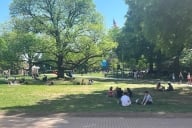You have /5 articles left.
Sign up for a free account or log in.
The start of the school year at the University of British Columbia (UBC) in Vancouver last month saw brand-new President Dr. Santa Ono flipping burgers at campus events and greeting students on Move-In Day.
But that wasn’t the only means by which he connected with his new campus. Ono was also livetweeting highlights, photos, and inspirational quotes to his new @ubcprez account.
During Ono’s tenure leading the University of Cincinnati, the popular president used the prominence of his position – and his Twitter account – with rare candour. Last spring, Ono shared the story of his own suicide attempts as a teenager with more than 70,000 Twitter followers; previously, he’d also spoken out in support of those struggling with depression, owning that he’d “been there” himself.
While his social media practices are by no means the norm among university senior administration (or faculty), Ono is not alone in using social networks to share his history and his daily engagements.
Does Ono’s example – and the positive response it’s generally garnered – mean scholars and university leaders should be encouraged to share personal or professional challenges publicly with students and colleagues?
Not necessarily.
***
A few weeks ago, George Veletsianos and I published a study exploring why and how scholars make disclosures on social media. In the study, we spoke to academics and higher education professionals using Twitter, blogs, Facebook, and other platforms as sites of both personal and professional disclosure. In the past, we described other aspects of the relationship between social media and scholarship. You can read more about our past research on this topic here and here.
The findings of the paper suggest that online disclosures by scholars tend to be selective, intentional, and approached with foresight. Contrary to the narrative that social media is a waste of time for “serious academics” or that Twitter is primarily a path to getting fired, our study found that most participants had relatively positive experiences with social networks, even in contexts of disclosure.
Still, exposing vulnerabilities in a professional context – particularly a context as hierarchical and traditionally aligned with depersonalized authority as higher education – can be risky, and feel threatening.
In the digital development work I do, I’ve learned that for many educators and scholars, even the personal-professional tone that social media rewards can be a real barrier to participating and contributing. For professionals accustomed to communicating in more formal registers, the casual tenor of social media exchange can be intimidating and silencing, even before serious disclosures are on the table.
But the study makes clear that, amongst the many scholars who do contribute to networked and digital conversations, there can be genuine benefits to disclosing times of trouble.
Some benefits are personal – the study found that disclosure of difficulties in social media spaces often generates care and support, and serves as an avenue for processing or coping with change. (Mileage may vary, of course, depending on the types of disclosures shared, the audiences accessed, and the ways in which troubles are framed and revealed.)
However, it’s the aspects of disclosure that go far beyond the personal that have real implications for contemporary higher ed.
They’re about what gets discussed, and by whom.
In the study, the central topics of disclosure amongst participants were quite varied; they ranged from professional challenges and setbacks through personal illnesses (mental and physical), the illnesses and deaths of loved ones, divorce, trans identity, queer identity, navigation of religious and racialized identities, and status issues within the academy itself.
We found that disclosures tended to be shared intentionally, generally with a sophisticated understanding of audience, within participants’ public online communities.
In many cases, the sharing was primarily personal in its origins and motivations. Some participants suggested it was easier for them to express vulnerability online than off. Others chose to share in order to better align their public and private senses of self - disclosures served to bring audience perceptions in line with lived experience.
But in many instances, even highly personal disclosures had another dimension: the political act of putting their face and voice behind an issue. Participants in the study repeatedly framed public disclosures as important and strategic forms of awareness-raising. This kind of tactical usage, aimed at leveraging an audience in order to increase visibility and empathy for a particular position or issue, is what Ono stepped up to do for depression and suicide in his role at UCincinnati.
Ono is not alone in his willingness to claim his struggles in hopes of helping others feel less alone in theirs. Many participants in our study - academics and higher ed professionals of all stripes - had done the same, and continue to do so.
And this is good for higher ed as a whole, because the more we acknowledge and humanize our differences and challenges in the academy - and particularly the more those with power are willing to make themselves vulnerable - the more we do to challenge stigma.
When one is unfamiliar with a particular channel or platform, or with the mixed personal/professional register that dominates a space like academic Twitter, it can seem as if forms of sharing within that space are indiscriminate. Yet George and I found that while participants’ disclosures were often intimate, vulnerable, and even professional risky, they were also carefully thought out and chosen with caution and forethought.
When administration and faculty and staff and students at an institution all use public online spaces to build genuine presence and connection, they’re engaging in visible leadership. When they use their platforms to challenge stigma and lend their voices and faces to making a difference, the institutional community benefits.
But. That doesn’t mean everybody in academia should be encouraged to rush out and post their deepest darkest moments on the internet.
***
Ono’s online presence should be seen as an apt illustration of scholarly social media done well. Ono’s disclosures – used to personalize and destigmatize very real campus issues – were generally received as courageous and welcome contributions to difficult but important conversations.
But as he said himself, “If I had no relationships and no social capital based upon social media, I think I would have been starting five steps behind.”
The participants in our study shared a great deal of positive feedback related to their disclosures, but the majority had spent time building presence and relationships on the platforms on which they chose to disclose. In those spaces, they tended to be firmly ensconced on the “resident” end of the Visitors & Residents continuum.
Residency is about presence. It’s about approaching a given online space as a social environment.
Social media differs from conventional scholarly communications in that it has no visible gatekeepers. But the absence of them doesn’t mean that one can just show up and be heard.
While Ono has genuine stature and a following on Twitter, even on his nearly brand-new UBC account, the goodwill his disclosure was met with did not come simply from the content of his message, nor from his formal status as a scholar or a President.
It was built over time, through Ono’s ongoing willingness to engage, to be present.
Had he made his disclosures without first establishing a voice, his words would likely have fallen on very few ears. Ono’s message got out there because he’d taken the time to get out there.
His model - and that of our participants - matters in higher ed.




